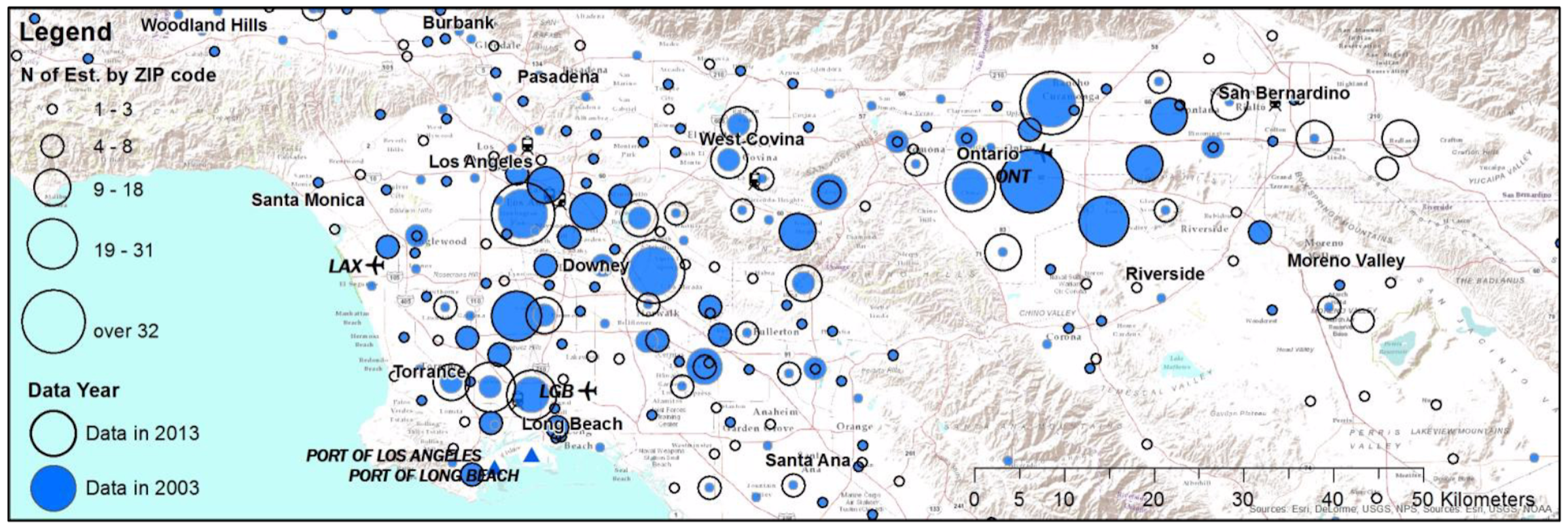News | METRANS Researchers Publish Findings on Spatial Dynamics of Logistics Facilities
Stop the VideoNews

METRANS UTC
METRANS Researchers Publish Findings on Spatial Dynamics of Logistics Facilities
Friday, July 1, 2016
by By Kaitlyn Zhang, MPP 2017
METRANS Transportation Center Director Dr. Genevieve Giuliano and Price School Ph.D. candidates Sanggyun Kang and Quan Yuan just published their latest research report called Spatial Dynamics of Logistics Facilities and Implications for Freight Flows this June. This research project is funded by the United States Department of Transportation (USDOT) and California Department of Transportation (Caltrans), through the National Center for Sustainable Transportation and METRANS Transportation Center.

Source: NCST Report Spatial Dynamics of Logistics Facilities and Implications for Freight Flows
Changes in the spatial pattern of warehousing and distribution (W&D) have caught the attention of scholars. Its impact on truck vehicle miles traveled (VMT) also poses an important research question in this and other projects. It is argued that W&D is moving away from the urban center (decentralizing) to avoid the high land costs, but increased truck VMT brings environmental impacts such as congestion, increased fuel consumption, and greenhouse gas emissions. The trade-off of cost savings to transport costs for logistics businesses will have further influence on the transportation network and the environment
The research team found that the W&D location change is inconsistent across California. Los Angeles M&D has decentralized the most, compared to other metro areas. The size of W&D also matters. Larger M&D facilities tend to locate further from urban center than smaller ones, while W&D facilities tend to concentrate together. In addition, data from 2003 to 2013 shows that the M&D facilities in Los Angeles and San Francisco are moving toward area with lower employment density, but the opposite trend is observed in San Diego and Sacramento.
Dr. Giuliano, Kang and Yuan identified three major factors: metropolitan size (population and correlated density), economic structure, and geographic characteristics. However, the mixed spatial characteristics for W&D in different metro areas make it hard to predict the effect of VMT impact. The location choice for W&D does not solely depend on rent, but also on other factors such as market location and labor force access. Additionally, the growth in e-commerce and the evolution of supply chain management and shipping patterns also play a role in W&D location choice. It is still too soon to conclude that the spatial changes of W&D facilities will lead to more truck VMT.
The full NACT report can be viewed here.
Genevieve Giuliano
Dr. Genevieve Giuliano is the Ferraro Chair in Effective Local Government and Professor and Senior Associate Dean of Research and Technology in the Sol Price School of Public Policy at University of Southern California, and the Director of the METRANS joint USC and California State University Long Beach Transportation Center. Her research focus areas include relationships between land use and transportation, transportation policy analysis, and information technology applications in transportation. Dr. Giuliano's current research includes analysis of growth and development of employment centers, examination of how ports and supply chains respond to environmental regulation, and a study of national transit policy.
Kaitlyn Zhang
Kaitlyn (Kenan) Zhang is a first-year Master of Public Policy (MPP) student attending the Sol Price School of Public Policy at the University of Southern California. Her interests are in transportation policy, urban development, and economics. She is also working towards a certificate in Transportation Systems from the Viterbi School of Engineering, and is an active student member of and volunteer for WTS Los Angeles.
News Archive
- December (1)
- November (6)
- October (4)
- September (2)
- August (3)
- July (4)
- June (3)
- May (7)
- April (8)
- March (11)
- February (8)
- January (7)
- December (7)
- November (8)
- October (11)
- September (11)
- August (4)
- July (10)
- June (9)
- May (2)
- April (12)
- March (8)
- February (7)
- January (11)
- December (11)
- November (5)
- October (16)
- September (7)
- August (5)
- July (13)
- June (5)
- May (5)
- April (7)
- March (5)
- February (3)
- January (4)
- December (4)
- November (5)
- October (5)
- September (4)
- August (4)
- July (6)
- June (8)
- May (4)
- April (6)
- March (6)
- February (7)
- January (7)
- December (8)
- November (8)
- October (8)
- September (15)
- August (5)
- July (6)
- June (7)
- May (5)
- April (8)
- March (7)
- February (10)
- January (12)















